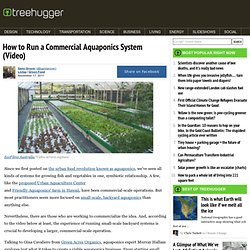

Central NY Aquaponic Farm, a Business and Testing Ground for Future of Agriculture. October 18, 2011 | Deanna Krinn What began as a business plan drawn up for fun has spawned Aqua Vita Farms, central New York’s first aquaponic farm.

Aqua Vita Farms was founded by Mark Doherty and seeks to provide wholesale food distributors with safe, high value, aquaponically grown seafood and produce. Retrofitting and construction on the company’s indoor farming facility, a 13,000 square foot building in Sherrill, N.Y. that was formerly a polishing facility for Oneida Silverware, kicked off in May of this year. The company, which currently raises bluegill fish, and grows lettuce, leafy greens and herbs in its custom-made aquaponic systems, had it first harvest shortly thereafter in August. Inspired by an article The idea for Aqua Vita Farms was inspired by an article that Doherty came across while reading the Wall Street Journal about a year and a half ago describing another aquaponic farm, Sweet Water Organics, he said. How to Run a Commercial Aquaponics System (Video) EcoFilms Australia/Video screen capture Since we first posted on the urban food revolution known as aquaponics, we've seen all kinds of systems for growing fish and vegetables in one, symbiotic relationship.

A few, like the proposed Urban Aquaculture Center and Friendly Aquaponics' farm in Hawaii, have been commercial-scale operations. But most practitioners seem more focused on small-scale, backyard aquaponics than anything else. Nevertheless, there are those who are working to commercialize the idea. And, according to the video below at least, the experience of running small-scale backyard systems is crucial to developing a larger, commercial-scale operation. Talking to Gina Cavaliero from Green Acres Organics, aquaponics expert Murray Hallam explores just what it takes to create a viable aquaponics business. I'd love to hear from anyone else who is practicing commercial-scale aquaculture too. DIY Covered Greenhouse Garden: A Removable Cover Solution to Protect Your Plants — Apartment Therapy Tutorials.
Planting season is upon us, so let me tell you a little story of how this garden came to be.

When we bought a house last year, I failed to inquire about the summer weather, thinking it would be just as warm and clear as it was on our open house day. NOPE. Instead, I encountered summers full of chilly fog and harsh winds, much to the dismay of my aspiring green thumb. Determined to keep home-grown veggies on our plates, I put my thinky-brain to work and thus, this covered greenhouse garden was born.
(Image credit: Stephanie Strickland) Materials Step 1: Assemble a raised garden frame with 2x12s (or stacked 2x6s to keep costs down) and staple a small-weave mesh to the underside to protect from burrowing pests. Step 2: Create the frame for your cover using 2x2s, with 2x4s for corner bracing. Step 3: Bend 10-ft PVC pipes to create the arches and attach them to the cover frame with pipe clamps. How to Build an Inexpensive Hoop-Style Greenhouse. One of the most valuable assets in my garden is my greenhouse.

It has allowed me to grow plants that I normally would not be able to grow, produce crops that the season is not usually long enough to produce, and protect my plants from frosts, hail, or other severe weather that normally would have destroyed my garden. But I don’t have thousands of dollars to spend on a greenhouse. I just priced out an 8’x12’ greenhouse for $3,500. I would love to have a large, professional greenhouse, but that simply isn’t financially feasible for me. So, instead I’ve found a way to make a large greenhouse that is functional, easy to build, and inexpensive. Required Materials List Note: All wood should be green, treated wood to resist rot. . (4) 2×6 – 16’(2) 2×6 – 12’(14) 2×4 – 12’(19) ¾” x 20’white pvc pipe(9) 10mm x 10’ rebar(1) 20’x50’ roll of 6mm plastic(1) Bundle of 50 4’ wood lathe (or optional staples)Zip tiesNails or screwsMetal bandingDoor hinges and handles.
Succulent Delights - DIY Hot House. Like to feed your entire family year round on fresh home grown produce?

Read on.... No matter where you live, keeping a healthy warm environment is essential for germinating seeds and growing your plants. In the colder regions of Australia a hot house will also allow you to grow vegetables all year round. A small hot house can either be made yourself or purchased relatively cheaply but neither offers the size whilst being a cost effective solution for growing a substantial crop. Here are the plans, materials list and steps to make a 6 meter long x 3.8 meter wide x 2.5 meter high hot house for under $500.00. Planning: In this example at a friends house, their was an existing structure (old barrier fence), but you really don’t need it – actually it’s preferable you don’t as the original fence was not straight and caused the whole structure to be slightly out of balance.
Construction: Step 1: Setting in the Rebar stakes Before you begin it’s a great idea to clear your work area. Day 1: Day 14: